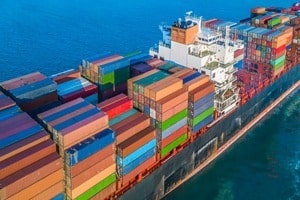What is a sea waybill?
The sea waybill: an important document in international sea freight traffic
The sea waybill is an accompanying document for shipments and is therefore usually found in international transactions. It performs two main functions:
- Receipt for the loaded goods
- Proof of the contract of carriage entered into
The sea waybill is issued by the carrier to the seller or the buyer, depending on the sales clause. This depends on who commissions the shipment. The carrier can then be either a freight forwarder or a shipping company directly.
As soon as the goods to be loaded have been stowed in a container or as general cargo on a ship, this consignment note is issued. These points are then included on the sea waybill:
- Details of the sender, the recipient and, if applicable the notifying freight forwarder
- If applicable, details of another party to be informed (e.g. the receiving forwarder)
- Port of loading and port of destination
- Place of receipt (if applicable) and final destination
- Ship name with the corresponding voyage number
- Description of the loaded goods
- Markings of the goods or the container number in FCL traffic
- Weight, dimensions and number of packages
- Date of loading
Sea waybill and bill of lading: the differences
The bill of lading is also a sea waybill. However, it has some additional functions compared to the sea waybill. The most important one is the commodity security. This means that the owner of an original bill of lading has a claim to the goods.
The fact that this document is a commodity security also makes it negotiable. This means that ownership of the goods named on the B/L can only be transferred from the seller to the buyer when the bill of lading is handed over. However, a sea waybill does not have this function. This is why banks do not accept the sea waybill in letter of credit transactions.
When does a sea waybill make sense?
A sea waybill eliminates the need to send original documents internationally. It therefore usually makes sense to have one issued in these cases:
- The goods to be transported have been paid for in advance
- The goods should not be resold during transportation
- There is a high level of trust between seller and buyer
However, sellers sometimes insist on a bill of lading being issued. However, if you do not wish to handle original documents, you can apply for a telex release. Your seller submits the issued bill of lading abroad to the shipping company, which immediately transfers ownership of the goods to you. The foreign organization of the shipping company now informs the local representative about this process and you receive your goods without the time-consuming process of document transfer.
Issueing a sea waybill: an example
The functions of a Sea Waybill are best explained using an example.
You buy goods from a long-standing business partner in China with whom you have a good relationship. Because of the mutual trust, you decide to use a sea waybill for the shipment of these goods. As the transaction is processed via the DAP clause, your seller books the container and the corresponding sea freight for the goods. He asks the shipping company to issue a sea waybill.
After the container has been loaded and the ship has departed, your business partner will receive the sea waybill by e-mail from the shipping company. He can now forward this to you and serves as proof that the goods have been legally handed over. After arrival at the port of destination, you can then dispose of the goods without further ado.
Important: Accidentally issuing the wrong bill of lading or sea waybill can have serious consequences afterwards. The release or payment process is often hindered, which can delay the delivery of the goods. It is therefore very important that all parties involved discuss which type of sea waybill will be issued – buyer, seller and shipping company/forwarder.
